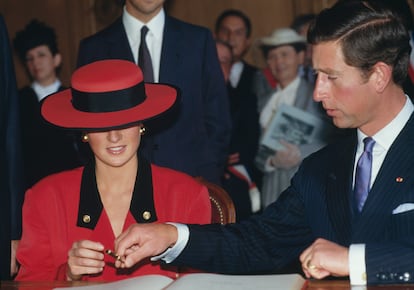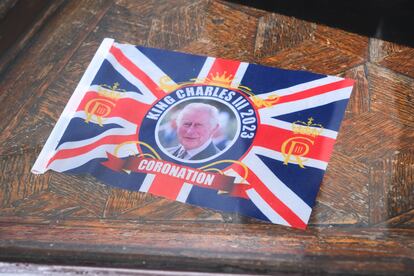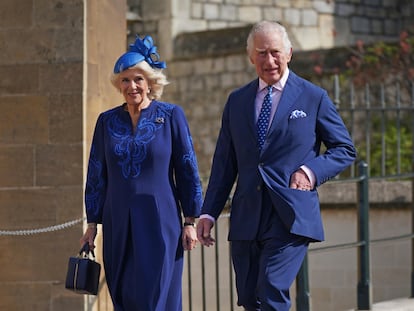Frustrated, ephemeral and second best: the Charles III that we have all seen on TV
In two weeks, England will crown its new king Charles III, but we have seen it all before. How has fiction treated Elizabeth II’s son, and might the turning points in the characters’ lives be repeated in real life?

“At last. My life has been a lingering for the throne”. These are the first lines of dialogue of the fictional Charles III as king. King Charles III (2017), a BBC 2 television adaption of Mike Bartlett’s play of the same name, shows the erstwhile Prince of Wales (played by Tim Pigott-Smith) refusing to sign a law passed by Parliament (something that has not happened since 1708), which he claims would harm the British people. In the most memorable scene in Rupert Goold’s production, Charles makes a surprise entrance into the House of Commons to dissolve parliament. The high drama of the play is a far cry from the first memorable images the new British monarch left to the world: a 70-something-year-old man wrestling with a fountain pen.
Kevin James, historian and professor at the University of Guelph, Canada, shares with ICON the expectations and difficulties he believes the public image of the former Prince of Wales faces. “It’s hard to imagine Charles replicating his mother’s style,” he says. “He doesn’t have much time to make his own mark as a monarch, even though he has spent a lifetime making his opinions public on various issues.”
The new monarch’s ascent to the throne has generated speculation about the future of the Crown and questions about its role in contemporary society. Charles has stated that, among other things, he will not live at Buckingham Palace and that in his coronation ceremony he has sought a kind of middle ground between tradition and the modern. “Perhaps his accession will make a difference in style and substance: a less discreet and more accessible crown,” James reflects.

More than 80% of living Britons were born during the seven-decade reign of Elizabeth II. Charles, on the other hand, was Prince of Wales for 64 years. It is hard to forget the image of the Queen as an embodiment of Britishness — her face is still on coins, vacation souvenirs, and even on the cover of the famous Sex Pistols single.
James emphasizes that the media has served as a tool to shape the Windsors’ public image. “The media have been instrumental in popularizing and disseminating very specific ideas about the monarchy,” he says. “The royal family has used them as a way to control the discourse about their own lives, albeit often unsuccessfully and with unintended consequences.”
The professor mentions several cases, such as the media coverage when Charles and Princess Diana separated, or the disastrous interview given by Prince Andrew (Charles’ brother) about his friendship with Jeffrey Epstein. A little-known example that speaks volumes about British royalty’s relationship with the media is Royal Family, a documentary made to celebrate the investiture of Charles as Prince of Wales in 1969. The BBC co-production with its independent rival, ITV, gave the British public a glimpse into the daily life of Queen Elizabeth, her husband Philip, Duke of Edinburgh and the rest of the House of Windsor with family meals, country walks and watching television. Critics condemned the frank and intimate portrayal of royal life and the 110-minute documentary has not been broadcast since 1977, even though it managed to leak onto the internet in 2019.

In one scene, we see Queen Elizabeth buying ice cream for her son. In another, she corrects a speech in the middle of a tour, and in a third, she reviews the day’s press. The documentary lifted a veil on the previously mysterious royals, and revealed a family more concerned about its public image than it ought to show to the world. Sir David Attenborough, in charge of content for BBC 2 at the time, put his condemnation of Royal Family in anthropological terms in a letter that resurfaced in the British tabloid, the Daily Express, in 2019: “The whole institution is sustained by the mystique of the tribal leader in his hut. If any member of the tribe looks inside the hut, the tribal leadership collapses and the tribe disintegrates.”
The man who could reign (at last)
For decades, fiction has played with the idea that King Charles III would be a breath of fresh air for the monarchy. Long before Mike Bartlett imagined Charles III in a power struggle against Parliament, the second season of Michael Dobbs’ House of Cards trilogy presented a monarch not unlike the former Prince of Wales pitted against a scheming prime minister.
House of Cards was born as a novel by the author, Michael Dobbs. He later confessed that he wrote it in anger against Margaret Thatcher when he worked as her chief of staff. It was originally adapted by the BBC in 1990, starring Ian Richardson as conservative politician Francis Urquhart (who would become Frank Underwood in the American version released by Netflix in 2013). However, it is The Crown, another stellar production on the streaming platform, that would shape the image of the House of Windsor for a new generation. One of the most memorable scenes from the fifth season shows the then Prince Charles (Dominic West) breakdancing with young people in a nightclub. It was one of those times that makes you press pause to Google what really happened.
A major theme of the fifth season, and perhaps of the entire series, is the paradox that defines royalty: years go by, governments change, society evolves, but the monarchy remains the same but separate (or at least it does its best to maintain that illusion). “The longevity of the British monarchy rests on its suspicion of the new and its distance in the face of popular pressure,” says James. The historian admits to not being a big fan of fictional works inspired by royalty: “The royal family has generated so much drama over the centuries that I find the dramatized elements excessive!”
The various fictions about the former Prince of Wales coincide in the idea of Charles as someone who is a reformer with as much energy as frustration, unable to act because of the very power that gives him his privilege. Diana’s ghost (literally, in Bartlett’s play) is an indelible stain that marks the life and image of the British monarch, a reminder of his human failings. Both King Charles III and the second season of House of Cards open with the funeral of Queen Elizabeth II and end with Charles forced to abdicate and Prince William crowned as British sovereign. The friction with the political establishment and the desire to bring a thousand-year-old institution into this century fail for the same reason: Charles the man’s private life and opinions clash with the expectations and desires of Charles the king.

“I think the idea of a monarch engaged in a crusade to bring the Crown closer to the people is a romantic idea,” says James. “There is an important distinction between the Crown as an institution and the person who wears it: the first represents a millennium of continuity and the other is mortal, ephemeral.”
Heavy is the head that wears the crown
Kevin James points out that, at the end of the day, there is not much difference between Charles, William or young Prince George, but it is all about maintaining the institution. After all, the king of Great Britain and Northern Ireland is also head of state of 15 nations spread over three continents. James, a Canadian of Scottish origin, highlights the peculiarity of living under a king who resides in another part of the world, thousands of miles away: “The debates that exist in Commonwealth nations are not focused on the monarch per se, but on the weight of the monarchy in the evolution of each country and what its role will be in the future, beyond its past.”
The historian emphasizes the current controversy revealed by the British newspaper The Guardian about the historic relationship of the King’s Household to the slave trade. “I wonder if the dialogue that has emerged about the Crown’s relationship with slavery reflects in part an openness to reflect on the institution’s central role with historical structures of oppression,” He speculates. “Perhaps, the recognition of these actions is the first step towards a reconciliation process. Carlos could be the right person for the job”.
Sign up for our weekly newsletter to get more English-language news coverage from EL PAÍS USA Edition
Tu suscripción se está usando en otro dispositivo
¿Quieres añadir otro usuario a tu suscripción?
Si continúas leyendo en este dispositivo, no se podrá leer en el otro.
FlechaTu suscripción se está usando en otro dispositivo y solo puedes acceder a EL PAÍS desde un dispositivo a la vez.
Si quieres compartir tu cuenta, cambia tu suscripción a la modalidad Premium, así podrás añadir otro usuario. Cada uno accederá con su propia cuenta de email, lo que os permitirá personalizar vuestra experiencia en EL PAÍS.
¿Tienes una suscripción de empresa? Accede aquí para contratar más cuentas.
En el caso de no saber quién está usando tu cuenta, te recomendamos cambiar tu contraseña aquí.
Si decides continuar compartiendo tu cuenta, este mensaje se mostrará en tu dispositivo y en el de la otra persona que está usando tu cuenta de forma indefinida, afectando a tu experiencia de lectura. Puedes consultar aquí los términos y condiciones de la suscripción digital.
More information
Archived In
Últimas noticias
Most viewed
- Reinhard Genzel, Nobel laureate in physics: ‘One-minute videos will never give you the truth’
- Oona Chaplin: ‘I told James Cameron that I was living in a treehouse and starting a permaculture project with a friend’
- Pablo Escobar’s hippos: A serious environmental problem, 40 years on
- Chevy Chase, the beloved comedian who was a monster off camera: ‘Not everyone hated him, just the people who’ve worked with him’
- Why we lost the habit of sleeping in two segments and how that changed our sense of time










































